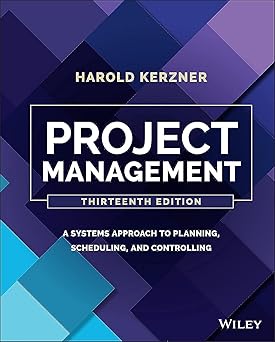Effective project management is crucial for organizations to achieve strategic goals. This white paper explores Harold Kerzner's "Project Management: A Systems Approach," emphasizing integrated project stages. We'll examine the systems approach, the Project Management Maturity Model (PMMM), implementation strategies, and tools, including the open-source ProjectLibre.
Project Management: A Systems Approach to Planning, Scheduling, and Controlling
Introduction
Effective project management is crucial for organizations to achieve strategic goals. This white paper explores Harold Kerzner's "Project Management: A Systems Approach," emphasizing integrated project stages. We'll examine the systems approach, the Project Management Maturity Model (PMMM), implementation strategies, and tools, including the open-source ProjectLibre.
The Systems Approach
Kerzner advocates a holistic view, seeing project management as an integrated system, not isolated processes. This improves coordination, resource optimization, and understanding of how each phase contributes to success.
Key Components
1. Project Management Maturity Model (PMMM)
The PMMM helps organizations assess and improve project management capabilities:
- Common Language: Shared project management vocabulary.
- Common Processes: Standardized processes and procedures.
- Singular Methodology: Unified methodology across the organization.
- Benchmarking: Comparing performance against best practices.
- Continuous Improvement: Regularly refining practices.
Example: An organization at level 1 might create a glossary and basic templates. Moving to level 3 might involve adopting Agile and training teams.
2. 16 Points to Project Management Maturity
Kerzner identifies 16 key elements:
- Consistent Methodology: Standardized approach (Agile, Waterfall, PRINCE2).
- Project Management Philosophy: Shared understanding of principles.
- Effective Planning: Thorough planning (scope, risks, resources). Use Case: Software development using user stories.
- Minimizing Scope Changes: Robust change management. Use Case: Construction project with formal change requests.
- Cost and Schedule Integration: Recognizing interdependence. Use Case: Earned Value Management (EVM).
- Right Project Manager: Skilled and experienced leaders.
- Executive Sponsorship: Active support from leadership. Use Case: Executive championing a critical project.
- Line Management Involvement: Engaging line managers.
- Deliverables Focus: Achieving tangible outputs. Use Case: Marketing campaign with defined deliverables.
- Communication and Cooperation: Open communication among stakeholders. Use Case: Regular meetings and reports.
- Shared Recognition: Acknowledging successes.
- Effective Meetings: Maximizing meeting efficiency.
- Early Problem Identification: Proactive issue identification. Use Case: Risk assessment workshops.
- Progress Measurement: Tracking progress against the plan.
- Project Management Software: Tools for execution and tracking.
- Continuous Training: Ongoing team development.
3. Behavioral Focus
Kerzner highlights the human element: leadership, communication, team dynamics, and positive work environment.
Project Management Tools: Including ProjectLibre
Tools enhance planning, scheduling, tracking, and control:
- ProjectLibre: Free and open-source, offering Gantt charts, resource management, task tracking, and reporting. Use Case: Non-profit using ProjectLibre for volunteer projects.
- Microsoft Project: Commercial software with comprehensive capabilities.
- Other Tools: Asana, Trello, Monday.com, Jira.
Tool selection depends on complexity, budget, and needs.
Implementation Strategies
- Methodology Adoption: Consistent methodology across projects.
- Executive Support: Buy-in from top management.
- Training and Development: Programs for all stakeholders.
- Continuous Improvement: Regular evaluation and refinement.
- Tool Implementation: Selecting and implementing software like ProjectLibre.
Benefits of the Systems Approach
- Higher Project Success Rates: Achieving objectives on time and budget.
- Optimized Resource Allocation: Efficient use of resources.
- Strategic Alignment: Projects aligned with organizational goals.
- Enhanced Stakeholder Satisfaction: Improved communication.
- Proactive Risk Management: Better risk identification and mitigation.
Conclusion
Kerzner's approach provides a robust framework for improving project performance. Focusing on maturity, behavior, continuous improvement, and tools like ProjectLibre drives success. Methodology, executive support, training, and the human element are crucial.
References
Books:
- Kerzner, H. (2017). Project Management: A Systems Approach to Planning, Scheduling, and Controlling. John Wiley & Sons.1
- Project Management Institute. (2021). A Guide to the Project Management Body of Knowledge (PMBOK Guide) – Seventh Edition. Project Management Institute.
- Wysocki, R. K. (2014). Effective Project Management: Traditional, Agile, Extreme. John Wiley & Sons. Papers/Articles:
- Turner, J. R., & Müller, R. (2003). On the nature of the project as a temporary organization. International Journal2 of Project Management, 21(1), 1-8. (Example academic paper - search for relevant papers on project management topics)
- Crawford, L. (2015). Agile project management for dummies. (Search for articles on specific methodologies or tools)
Websites:
- Project Management Institute (PMI): www.pmi.org
- ProjectLibre: www.projectlibre.com
- (Add links to other relevant websites, blogs, or resources. For example, if you discuss a particular Agile framework, link to a relevant resource on that framework. If you mention a specific risk management technique, link to a resource that explains it.)
It's important to note that academic referencing often requires specific formatting (APA, MLA, Chicago, etc.). The examples above are general, and you should consult a style guide if you are writing a formal paper. Also, always double-check the accuracy of URLs and publication details. When researching, look for reputable sources like academic journals, industry publications, and established organizations.
Additional Resources:
- Project Management: A Systems Approach to Planning, Scheduling, and Controlling
- Competitive Advantage in the Age of AI: A Framework for the Fourth Industrial Revolution
- White Paper Title: The Power of Integrated Digital Marketing: A Synergistic Approach to Online Success
- The Supercommunicator: Mastering the Art of Connection
- White Paper: Building a Powerful Online Presence: A Comprehensive Guide to Website Design and Development for SMEs
- White Paper: Mastering Email for Small Business Success: A Comprehensive Guide to Clients, Servers, and Marketing
